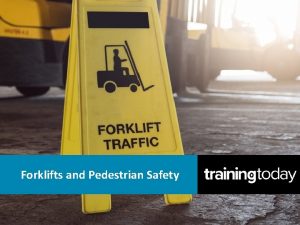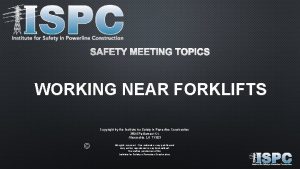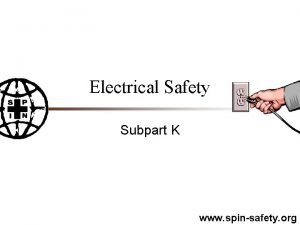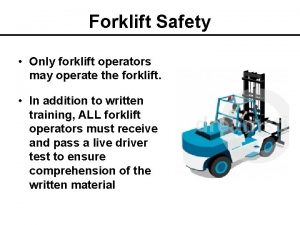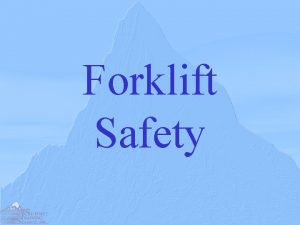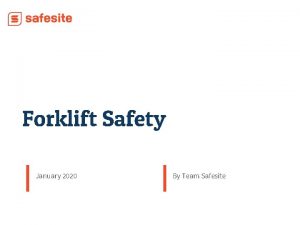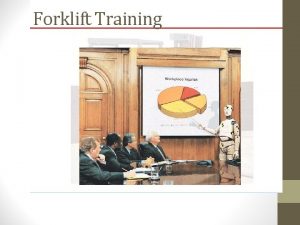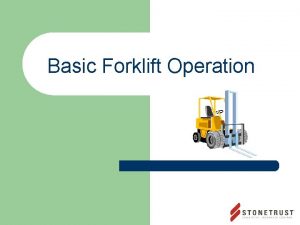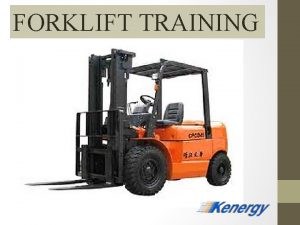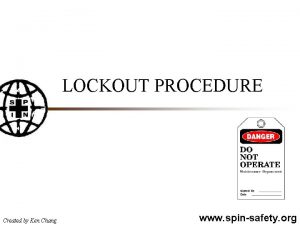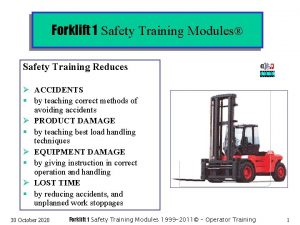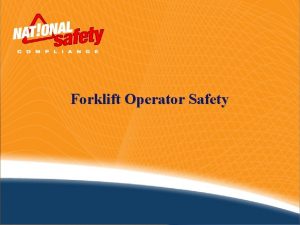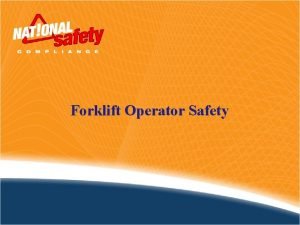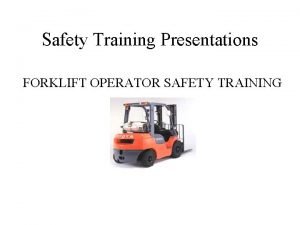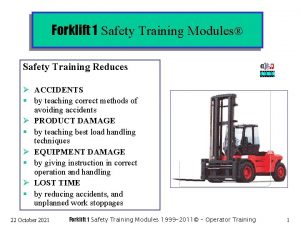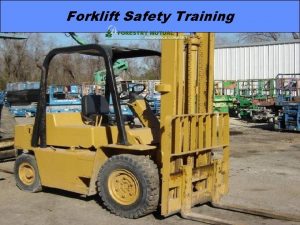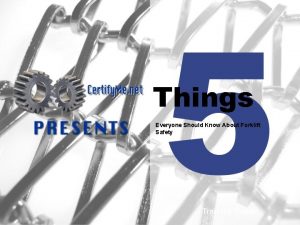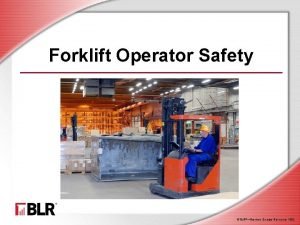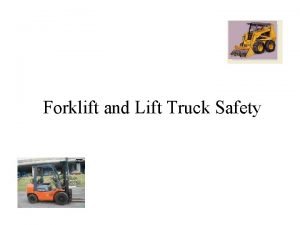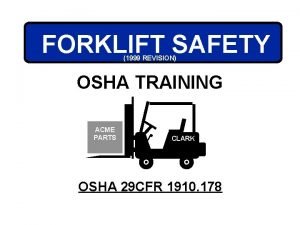Forklift Safety www spinsafety org Disclaimer The information






















- Slides: 22

Forklift Safety www. spin-safety. org

Disclaimer The information presented in this presentation has been compiled from sources believed to be reliable and is intended to be a tool to assist and guide you in building your own presentation. This program may not address all the hazardous conditions or unsafe acts that may exist. For that reason, SPIN cautions users to confirm accuracy and compliance with the latest standards and best practices. Local, State/Provincial and Federal regulations take precedence over this material. Implementation of any practices suggested by this program is at your sole discretion, and SPIN will have no liability to any party for any damages including, but not limited to, direct, indirect, special or consequential damages, arising out of or in connection with the information provided or its use.

Forklift Safety Training n n n n Safe operating procedures of a forklift The pre-operation inspection checklist Safe loading and unloading of trailer Safe fueling procedures Written Evaluation Operator performance test Retraining

Most Common Accidents n n Person or object struck by forklift. Material falls on bystander or operator. Operator is injured getting on or off equipment. Forklift tips over because the rated load capacity is exceeded, or the load is handled improperly. – Approximately 34, 000 injuries a year.

Safe Operating Procedures n n n Employee’s must be trained and authorized before operating a forklift. Know all safety devices and functions. Mount and dismount correctly Perform pre-operational inspection Never operate a forklift in need of repair Never operate a forklift for any purpose other than what it was designed for

n n n Keep hands and steering free of slippery material. Operate the forklift only from the operator’s position. Always travel at safe speeds. Never allow any other person to ride on the forks or anywhere else. A safety platform is the only exception, because it is designed for a passenger.

Fueling Procedures n n n n n No smoking or use of open flames Shut off the forklift before fueling Avoid breathing the fumes Be sure you are using the proper fuel (Taxable Diesel) Avoid overfilling the tank Clean up any spills before starting the unit Replace the fuel cap Watch for leaking fuel lines Wear eye protection and other protective gear

Pre-Operational Checklist n n n All forklifts will be inspected before each shift of operation. If repairs are needed, it will be tagged “Out of Service” until repairs are completed. A work order will be completed identifying repair needs.

Pre-Operational Inspection BASIC FORKLIFT PRINCIPLES

Pre-Operational Inspection þ MAST þ CYLINDER MOUNTING HARDWARE þ ROLLER TRACKS AND CHAINS þ TIRES þ FORKS AND ADJUSTMENT þ LIGHTS AND WARNING DEVICES þ FLUID LEVELS þ HANDBRAKE þ HYDRAULIC LINES þ STEERING AND BRAKES þ LIFT AND TILT CYLINDERS þ DRIVING CONTROLS þ OVERHEAD GUARD MOUNTING þ LIFT CONTROLS þ FIRE EXTINGUISHER þ SEAT ADJUSTMENT AND BELTS

Leaving a Forklift Unattended n n n Fully lower forks Neutralize controls Set brakes Turn off the motor and remove the key If parked on an incline, block the wheels Never park in front of emergency exits

Picking up loads n n n n Never exceed the rated capacity of your unit Forks must be spaced properly Be sure the load is stacked properly and is balanced Secure the load to the pallet Drive into load as far as possible Tilt the load back slightly & then lift it Watch for overhead objects or side objects Lower load 4 to 6 inches above ground level for travelling


Lifting Principle REAL HEAVY PARTS LOAD CAPACITY 6000 lbs 6500 lbs INCORRECT PROPANE ONLY LOAD CAPACITY 6000 lbs 6500 lbs PROPANE ONLY CORRECT

TYPES OF FORKS þ HALF-TAPERED FORKS - USED WITH HEAVIER LOADS þ FULL-TAPERED FORKS - USED WITH LIGHTER LOADS - USED WITH NARROW PALLETS FORK ADJUSTMENT FORKS SHOULD BE SPREAD AS WIDE AS POSSIBLE TO ALLOW FOR MAXIMUM STABILITY OF THE LOAD!

Traveling with loads n n n Pedestrians have the right-of-way Look in the direction of travel Forks should be 4 to 6 inches above ground level if terrain permits Mast should be angled slightly back Slow down and sound horn when approaching blind corners Drive in reverse if your forward vision is obstructed

n n n n n Do not lift or lower a load while travelling Go down an incline in reverse and up an incline going forward Turning to fast can cause a load to shift or fall Starts and stops should be gradual Never let anyone ride on your forklift Be aware of slippery surfaces, bumps or holes Safe following distances (at least 3 vehicle lengths) Keep limbs inside compartment Seat belts must be worn at times while in operation

Trailer Operations þ ENSURE THE TRAILER FLOOR IS RATED FOR THE VEHICLE WEIGHT þ VERIFY THAT THE TRAILER FLOOR IS IN SERVICEABLE CONDITION þ ENSURE THE FORKLIFT WILL NOT UNBALANCE THE TRAILER þ USE ADDITIONAL TRAILER SUPPORTS IF UNBALANCING IS A RISK þ CONSIDER THE INTERIOR TRAILER HEIGHT þ ENSURE THE TRAILER CANNOT ROLL AWAY FROM THE DOCK þ CONSIDER LIGHTING AND INCLEMENT WEATHER

Stacking & Dropping Loads n n n Never stand under a load that is raised Always move slowly when the load is raised When stacking insure that the load is level and secure Stack round objects tightly together and place chock or block Be careful when backing out of a load where a pedestrian is in your pathway

Lift Classifications & Rated Load Capacity n n n The maximum amount of weight that can be safely lifted. The rated capacity of a forklift can be found on the identification plate on the forklift, or in the manufacturer’s Operator’s Manual. To test the load’s weight, the operator should: 3 Lift the load one or two inches 3 Make sure it is firm and stable


As a Safety Professional, SPIN encourages you to submit safety resources that are particularly beneficial to fellow Safety Professionals. We welcome your suggestions and thank you for your input. Please use the following instructions when submitting resources. 1. Please include your full name (first & last) in the subject section of the your email 2. Please include a brief description, name of program and version of any and all files submitted 3. Please use a compression program, like Win. Zip, when submitting multiple or large files 4 Please include appropriate contact information (name, phone number, etc. ) when referring potential new members 5. Include links to safety related URL's in the description section 6. Please send photos and graphic files as 72 dpi jpg, tif or gif files submit all items to: info@spin-safety. org For more information about SPIN visit the web-site at www. spin-safety. org or call 1 -800 -673 -0439
 Forklift pedestrian safety
Forklift pedestrian safety Forklift safety meeting topics
Forklift safety meeting topics Hát kết hợp bộ gõ cơ thể
Hát kết hợp bộ gõ cơ thể Frameset trong html5
Frameset trong html5 Bổ thể
Bổ thể Tỉ lệ cơ thể trẻ em
Tỉ lệ cơ thể trẻ em Voi kéo gỗ như thế nào
Voi kéo gỗ như thế nào Thang điểm glasgow
Thang điểm glasgow Bài hát chúa yêu trần thế alleluia
Bài hát chúa yêu trần thế alleluia Kể tên các môn thể thao
Kể tên các môn thể thao Thế nào là hệ số cao nhất
Thế nào là hệ số cao nhất Các châu lục và đại dương trên thế giới
Các châu lục và đại dương trên thế giới Công thức tính thế năng
Công thức tính thế năng Trời xanh đây là của chúng ta thể thơ
Trời xanh đây là của chúng ta thể thơ Mật thư tọa độ 5x5
Mật thư tọa độ 5x5 101012 bằng
101012 bằng độ dài liên kết
độ dài liên kết Các châu lục và đại dương trên thế giới
Các châu lục và đại dương trên thế giới Thể thơ truyền thống
Thể thơ truyền thống Quá trình desamine hóa có thể tạo ra
Quá trình desamine hóa có thể tạo ra Một số thể thơ truyền thống
Một số thể thơ truyền thống Cái miệng nó xinh thế
Cái miệng nó xinh thế Vẽ hình chiếu vuông góc của vật thể sau
Vẽ hình chiếu vuông góc của vật thể sau
